

Strength in Numbers: State Spending on K-12 Assessment Systems. In the coming years, states will need to make the most significant changes to their assessment systems in a decade as they implement the Common Core State Standards, a common framework for what students are expected to know that will replace existing standards in 45 states and the District of Columbia.
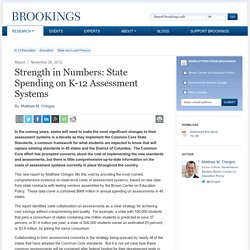
The Common Core effort has prompted concerns about the cost of implementing the new standards and assessments, but there is little comprehensive up-to-date information on the costs of assessment systems currently in place throughout the country. This new report by Matthew Chingos fills this void by providing the most current, comprehensive evidence on state-level costs of assessment systems, based on new data from state contracts with testing vendors assembled by the Brown Center on Education Policy. These data cover a combined $669 million in annual spending on assessments in 45 states.
Trends to Watch in 2015: From Algorithmic Accountability to the Uber of X. Target, Neiman Marcus will make security better, McAfee privacy boss says. Thinkstock Portals of opportunity for hackers.

With the revelations of NSA spying and recent high-profile hacks like those against Target and Neiman Marcus, it seems like online privacy has never been weaker. But that's not the case, said McAfee Chief Privacy Officer Michelle Finneran Dennedy. The computer security veteran, whose company is ditching the McAfee name and adopting the Intel Security brand, said that recent privacy breaches have woken people up to the real issues and have created organic demand for privacy-saving services for the first time.
Education Week. Diving into Data Analytics Tools in K 12. EdSurge Newsletters Receive weekly emails on edtech products, companies, and events that matter.

The use of data to influence decision-making isn’t new to K-12 education. How Can Teachers and Schools Use Data Effectively? Brief. Over the past decade, educational policymakers have consistently called for data use.
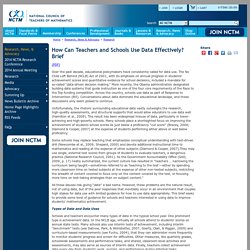
The No Child Left Behind (NCLB) Act of 2001, with its emphasis on annual progress in students’ achievement scores and quantitative evidence for school decisions, included a mandate for so-called “data-driven decision making.” More recently, the Obama administration designated building data systems that guide instruction as one of the four core requirements of the Race to the Top funding competition. Across the country, schools use data as part of Response to Intervention (RtI). 6 Tips for Leading with Data for School Improvement. By Ellen Goldring and Mark Berends Goldring and Berends are authors of the AASA book Leading with Data: A Path to School Improvement, published by Corwin Press.
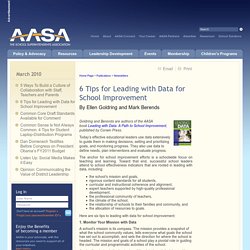
Today’s effective educational leaders use data extensively to guide them in making decisions, setting and prioritizing goals, and monitoring progress. They also use data to define needs, plan interventions and evaluate progress. Consumer-aware, context-aware. Every December, my company produces a report highlighting the tech trends that we think will make the biggest impact in the year to come.

The report is built using a tool I developed called the FuturePrint, and calculates the near-future research we do along with patent filings, academic papers, shifts in consumer behavior, changes in government policy, new investments and acquisitions, microeconomic trends, and the like. This year, we published 55 trends (our largest to date) — but from my point of view, only one matters most for those in the news business: Consumers — not their devices — must be the focus of any content strategy in 2015. When I’ve suggested this to newsroom managers and executives before, I hear the same response: That’s what we’re already doing. Don’t you notice how our app fits both your Galaxy Tab and your iPhone? Responsive design doesn’t address the consumer’s needs. Think about the last story you wrote or helped create.
Those are activities. Finding The Elusive Big Wisdom In Big Data. You probably already know ‘Big Data’ is top of mind heading into 2015.
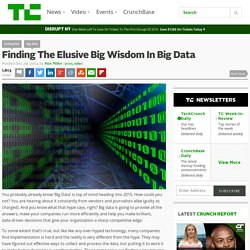
How could you not? You are hearing about it constantly from vendors and journalists alike (guilty as charged). To Analyze or Not to Analyze. Much has been written about Big Data and how it changes all facets of our lives.
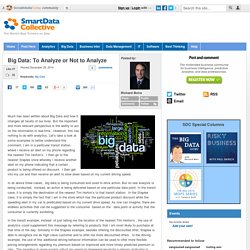
But the important and more relevant perspective is the ability to act on the information in real-time. However, this has nothing to do with analytics. Let’s take a look at some examples to better understand this comment. I am in a particular transit station where I receive an alert on my phone regarding the nearest Tim Horton’s. I then go to the nearest Staples store whereby I receive another alert on my phone indicating that a certain product is being offered on discount. In all above three cases, big data is being consumed and used to drive action.
A Look at Analytics, Business Intelligence, Big Data, Clustering, Manufacturing & Innovation. 6 tech trends for 2015 that will change our future. Technology and innovation can be frustrating to watch in action.
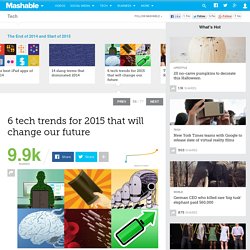
That’s because there usually isn’t much action — just incremental change with occasional flashes of brilliance. But the only way to truly understand what’s happening and why is to keep watching. Breakthroughs from years ago are finally leading to real products and services today. Others are inching forward with the promise of big changes in 2015 and beyond. Of course, you have to know where to look. 1. Image: Mashable, Bob Al-Greene.